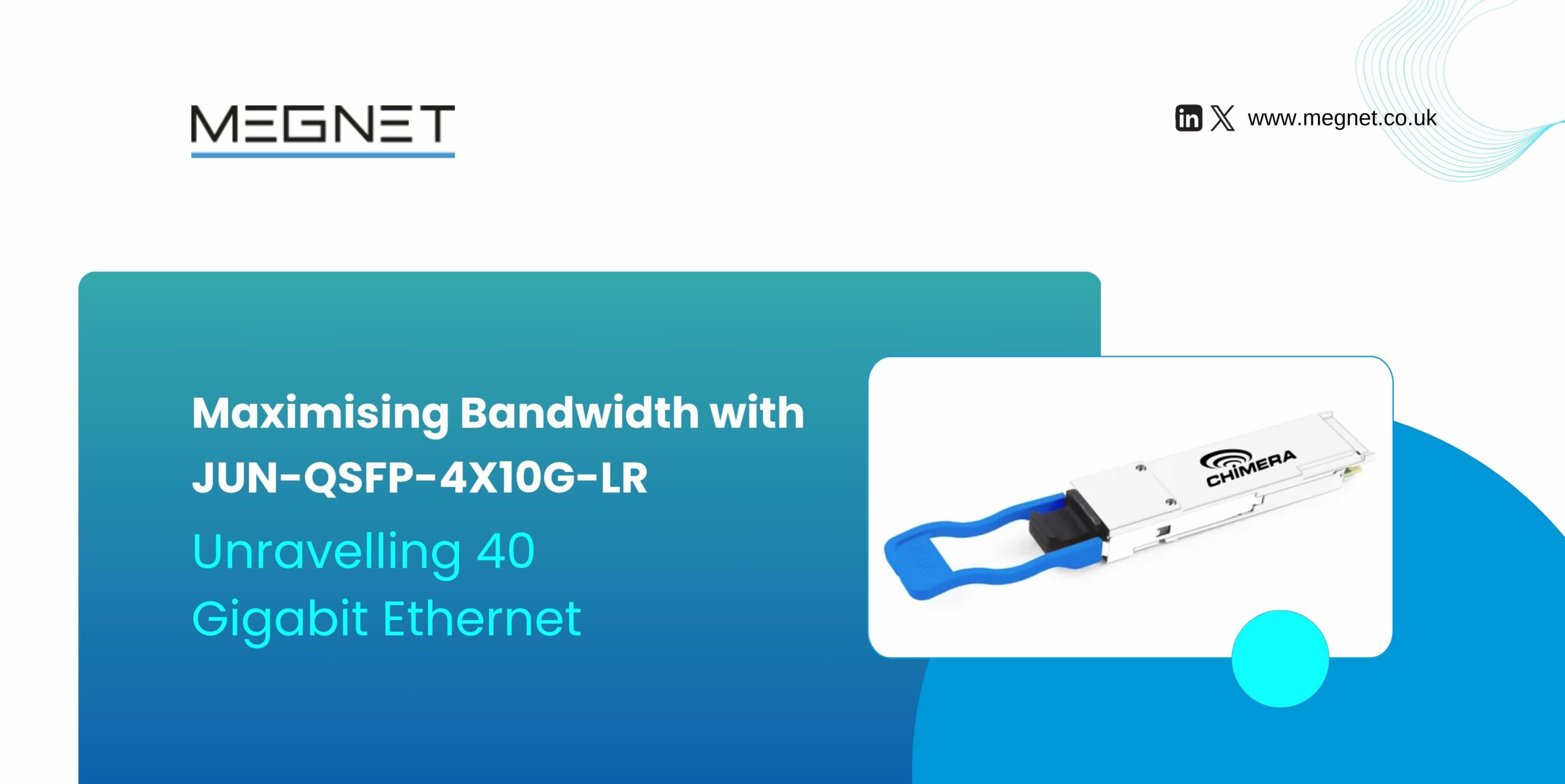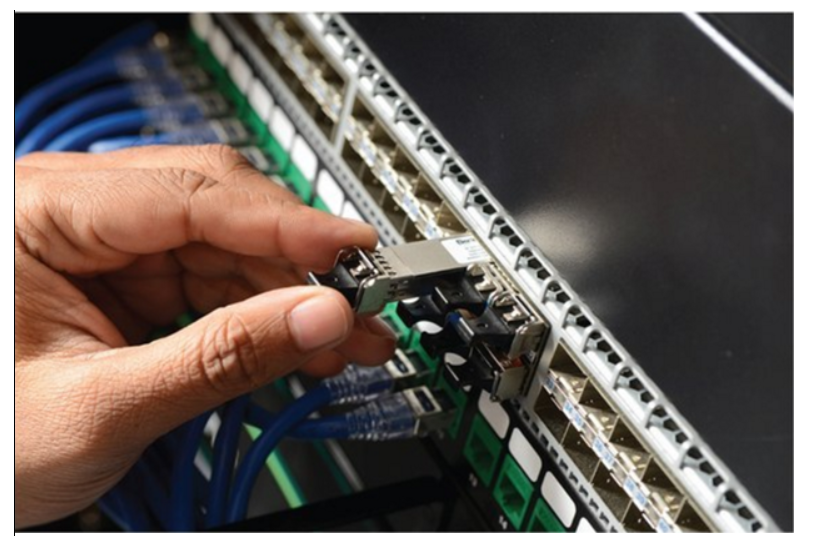
40GbE Powerhouse: The JUN-QSFP-4X10G-LR Revolutionises Data Centre Performance
The data deluge is relentless. Today’s data centres grapple with ever-increasing demands for processing power, storage capacity, and – most importantly – bandwidth. Traditional 10 Gigabit Ethernet (10GbE) solutions are struggling to keep up, leaving data centres vulnerable to bottlenecks and sluggish performance. But fear not, there’s a solution on the horizon: 40 Gigabit Ethernet (40GbE) technology.
This blog delves into the world of 40GbE, specifically focusing on the JUN-QSFP-4X10G-LR transceiver – a game-changer for high-bandwidth connectivity in your data centre. We will explore how 40GbE unlocks significant performance improvements, dissect the JUN-QSFP-4X10G-LR technical specifications, and highlight its advantages for data centre networking. Buckle up and get ready to Unravel 40GbE with the JUN-QSFP-4X10G-LR.
The Need for Speed: Why 40GbE?

The ever-growing demands for data processing and storage in today’s data centres are pushing the boundaries of network infrastructure to their limits. Our trusty workhorses, the traditional 10 Gigabit Ethernet (10GbE) solutions, are starting to struggle. They just can’t keep up with the ever-increasing volume and lightning-fast speeds of modern data traffic.
Here is why you might be considering an upgrade:
Faster Transfer Rates, Mate! Imagine whizzing massive datasets, virtual machines, and real-time applications around your network at four times the speed of 10GbE. That’s the kind of boost 40GbE offers, making your data centre run smoother than a freshly paved motorway.
Scalability for the Future? No more costly network overhauls every time your data demands grow. 40GbE lets you scale your infrastructure efficiently, accommodating future bandwidth needs without breaking the bank.
With 40GbE, you can handle more traffic using fewer connections. That means a simpler, less cluttered network, leading to reduced complexity and lower operational costs. It’s all about working smarter, not harder, isn’t it?
The JUN-QSFP-4X10G-LR transceiver plays a pivotal role in achieving these benefits. Let’s delve deeper into its technical specifications and functionalities to see how it makes this magic happen.
Use Cases for JUN-QSFP-4X10G-LR in Data Centres
The JUN-QSFP-4X10G-LR transceiver offers significant benefits for various data centre applications due to its ability to deliver 40 Gigabit Ethernet (GbE) connectivity. Here are some common use cases:
High-Bandwidth Streaming Services: Data centres supporting video streaming services with large user bases can benefit from 40GbE’s faster data transfer rates. This ensures smooth, high-quality streaming without buffering, even during peak usage times.
Cloud Storage and Processing: Businesses increasingly rely on cloud-based applications. 40GbE with the JUN-QSFP-4X10G-LR allows for faster data uploads and downloads to the cloud, improving performance for cloud storage and processing tasks.
Server Virtualization: Data centres running multiple virtual machines on a single server can leverage 40GbE to provide sufficient bandwidth. This ensures all virtual machines operate smoothly without lag or downtime.
Big Data Analytics: When working with massive datasets for data analytics, 40GbE with the JUN-QSFP-4X10G-LR facilitates faster data transfer and analysis. This enables quicker turnaround times for critical data insights.
Interconnecting Remote Offices: The JUN-QSFP-4X10G-LR’s long-distance capabilities are ideal for connecting geographically dispersed data centres or remote offices to a central facility. This provides a high-bandwidth connection as if they were located in the same building.
Unveiling the JUN-QSFP-4X10G-LR Transceiver

The JUN-QSFP-4X10G-LR transceiver is a game-changer for data centres needing to ramp up their bandwidth. This nifty bit of kit, built to the QSFP standard, packs a powerful punch, allowing you to achieve 40 Gigabit Ethernet (GbE) connectivity over impressive distances. Let’s delve into its technical specs and see how it works under the bonnet.
Technical Breakdown:
Form Factor: The QSFP+ (Quad Small Form-factor Pluggable Plus) design makes it a hot-swappable module, meaning you can easily add or remove it from your network gear without powering down the whole kit and caboodle. That’s a win for maintenance and flexibility.
Interface: This blighter boasts a 4-channel 10 Gigabit electrical interface. Think of it like having four lanes on a motorway, each carrying a hefty 10 Gigabits of data per second.
Wavelength: Operating at a wavelength of 1310 nanometres (nm), the JUN-QSFP-4X10G-LR is perfect for long-distance applications. This specific wavelength travels well through single-mode fibre optic cables, allowing you to connect devices that might be quite a distance apart, be it across different floors in a data centre or even between buildings on a campus.
Glorious Distance:
Depending on the specific model, the JUN-QSFP-4X10G-LR can conquer distances of up to 10 kilometres (km) or a whopping 40 km! That’s perfect for situations where you need to connect geographically dispersed data centre facilities or link up remote offices. No more worries about wimpy connections cramping your data transfer style.
MTP/MPO Connector:
The JUN-QSFP-4X10G-LR utilises an MTP/MPO connector. This fancy term refers to a multi-fibre push-on/pull-off connector. It’s specifically designed for use with ribbon cables, which bundle together multiple individual fibres within a single sheath. This makes for high-density connections, ideal for data centres where space is at a premium. So, you should choose the MTP or MPO cable for your optical transceiver.
Inner Workings:
Now, how does this marvel of engineering actually work its magic? The JUN-QSFP-4X10G-LR acts as a translator between the electrical signals zipping around your network devices and the light pulses used for data transmission over fibre Long-Reach Optics cable. It takes the incoming electrical signal, chops it up into four channels, and then modulates each channel onto a separate laser beam using a specific wavelength. These laser beams then race down the fibre optic cable, carrying your data across vast distances. On the receiving end, the process is reversed – the light pulses are converted back into electrical signals, ready to be interpreted by the receiving network device.
Bonus Feature: Digital Diagnostics Monitoring (DDM)
The JUN-QSFP-4X10G-LR has a hidden gem up its sleeve – Digital Diagnostics Monitoring (DDM). This nifty feature acts like a little doctor, constantly checking the 40GbE QSFP+ Transceiver’s vital signs. It monitors things like temperature, laser bias current, optical power output, and voltage supply. By keeping an eye on these parameters, DDM allows you to:
Proactively maintain your network: Catch potential problems before they snowball into major outages.
Optimise performance: Ensure the transceiver is operating within optimal conditions for reliable data transmission.
Troubleshoot issues: Gain valuable insights to diagnose and resolve network connectivity woes.
With DDM on your side, you can be confident that your JUN-QSFP-4X10G-LR transceiver is running smoothly and keeping your data flowing freely.
Unleashing the Power of 40GbE in Data Centres

Imagine your data centre as a bustling motorway. Gigabytes of data whizz by like lorries carrying crucial information. But lately, the traffic’s gotten a bit, well, gridlocked. 10 Gigabit Ethernet (GbE), the trusty old workhorse, is struggling to keep up with the ever-growing demands. That’s where 40GbE swoops in, a shiny new motorway expansion project ready to alleviate the congestion and get your data flowing freely once more.
The JUN-QSFP-4X10G-LR transceiver is the key that unlocks the door to this high-speed data highway. Here’s how it injects some serious oomph into your data centre:
Bandwidth Blitz: Buckle up for a four-fold increase in bandwidth compared to 10GbE. That’s like adding extra lanes to your data centre motorway, allowing more information to travel simultaneously. Think faster file transfers, smoother cloud applications, and a significant reduction in those dreaded lag spikes.
Scalability Savvy: Ever feel like your data centre is bursting at the seams with information? Fear not! 40GbE, with the help of the JUN-QSFP-4X10G-LR, is your future-proofing champion. As your data demands inevitably grow, you can seamlessly scale your network infrastructure without needing a complete overhaul. It’s like adding extra lanes to the motorway as and when traffic increases, keeping things running smoothly.
Cable Count Caper: We all know the struggle of untangling a monstrous mess of cables in a cramped data centre. 40GbE brings good news! By achieving the same bandwidth with fewer cables, you can create a more organised and streamlined environment. Imagine a data centre motorway with fewer lanes, but each lane carries more traffic – that’s the magic of 40GbE with the JUN-QSFP-4X10G-LR. Not only will it improve airflow (think less heat, more efficiency!), but it’ll also make troubleshooting a breeze. No more spelunking through a tangled web of cables!
Power Play: While not always a guaranteed win, 40GbE solutions have the potential to be more power-efficient per unit of bandwidth compared to multiple 10GbE connections. It’s like getting more miles per gallon on your data centre motorway – good for the environment and your energy bills!
Distant Data Doddle No More: Got geographically dispersed data centres? The JUN-QSFP-4X10G-LR boasts long-reach capabilities, perfect for connecting these facilities. Imagine extending your data centre motorway across vast distances, ensuring seamless information flow between your sites.
Compatibility with Juniper Networks Equipment
Compatibility is crucial when choosing transceivers. The JUN-QSFP-4X10G-LR transceiver is specifically designed to work seamlessly with a range of Juniper Networks switches and routers.
It is essential to verify Juniper Networks Compatibility information provided by Juniper Networks before purchasing transceivers to ensure optimal performance and avoid potential network issues. Additionally, using genuine Juniper-branded transceivers offers the assurance of guaranteed compatibility, performance, and long-term reliability.
Digital Diagnostics Monitoring (DDM): Optimising Performance
Imagine having a trusty mechanic under the bonnet of your data centre’s network, constantly checking its vitals. That’s what Digital Diagnostics Monitoring (DDM) does for your JUN-QSFP-4X10G-LR transceiver. This nifty feature provides real-time insights into its inner workings, keeping your network running like a well-oiled machine.
Think of DDM like a dashboard displaying key metrics. Here’s what it keeps an eye on:
Temperature: Just like keeping your engine from overheating, DDM monitors the transceiver’s internal temperature. If things get a bit too toasty, you will receive an alert, allowing you to take preventative action before it disrupts your network tea break.
Laser Bias Current: Picture the laser in the transceiver as the engine that propels your data. DDM tracks the current supplied to this laser, ensuring it operates within optimal parameters for a strong, steady signal. A wobbly current could lead to garbled data, so DDM helps keep things running smoothly.
Optical Power Output: This one’s about ensuring your data reaches its destination with a good shove. DDM measures the power level of the light signal blasting out of the transceiver. If the power dips, it could indicate a problem with the laser or fibre, and DDM will be there to sound the alarm.
Voltage Supply: Imagine your network as a bustling city – it needs a stable power supply to function. DDM monitors the voltage levels feeding the transceiver, ensuring it has the juice it needs to keep the data flowing. Any fluctuations could disrupt operations, and DDM helps nip them in the bud.
By keeping tabs on these vital signs, DDM empowers you to:
Become a proactive network ninja: Identify potential issues before they snowball into network meltdowns. Imagine catching a flickering lightbulb before the whole room plunges into darkness – that’s the preventative power of DDM.
Optimise performance: Just like a well-tuned engine delivers the best performance, DDM ensures the transceiver operates within ideal conditions for reliable data transmission. It’s all about keeping your network firing on all cylinders.
Troubleshoot like a boss: When network gremlins strike, DDM provides valuable clues to help you diagnose and fix the problem. It’s like having a network stethoscope that pinpoints exactly where the gremlins are hiding.
Conclusion
In conclusion, the JUN-QSFP-4X10G-LR transceiver empowers you to unlock the potential of 40 Gigabit Ethernet, delivering a significant boost in bandwidth and network efficiency for your data centre. From faster data transfer speeds to future-proof scalability, this innovative solution empowers you to handle growing data demands with ease.
Ready to unlock the power of 40GbE in your data centre? Explore the comprehensive selection of JUN-QSFP-4X10G-LR transceivers and other networking solutions at Megnet. Our team of experts is here to guide you in selecting the right products for your specific needs. Visit Megnet to browse our inventory and contact us today!
FAQ's
40GbE offers significantly faster data transfer rates, improved scalability, and increased network efficiency compared to 10GbE.
This transceiver is ideal for data centres, high-performance computing environments, and applications requiring high-bandwidth connections over long distances (up to 10km or 40km).
It converts electrical signals from the network device into optical signals for transmission over fibre optic cable . It utilises four independent 10GbE channels to achieve a combined bandwidth of 40GbE.
It offers a significant boost in bandwidth compared to 10GbE solutions, enabling faster data transfer rates.
This transceiver allows for cost-effective network expansion to accommodate future growth and bandwidth demands within the data centre.
Yes, 40GbE with the JUN-QSFP-4X10G-LR requires fewer cables compared to 10GbE for the same bandwidth, leading to improved cable management and airflow.
While the transceiver itself doesn't directly enhance security, proper physical security measures are crucial for fibre optic cables carrying your data. This may involve securing cable trays and entry points to prevent unauthorised access.
Encryption is typically implemented at the network device level, not within the transceiver itself. Consult your network security protocols for data encryption on your network.
40GbE is a well-established standard, but future advancements in networking technologies may introduce new transceiver types. Consider future scalability needs when making purchasing decisions.
DDM or Digital Diagnostics Monitoring in JUN-QSFP-4X10G-LR provides valuable real-time information about the health and performance of the transceiver itself, as well as the optical fibre link it's connected to. This allows for proactive network monitoring, faster troubleshooting, and overall improved network efficiency.








Leave a comment
Your email address will not be published. Required fields are marked *